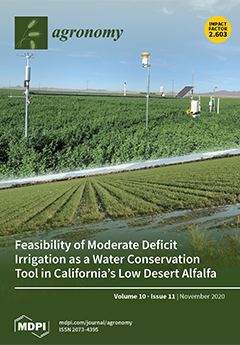Excessive phosphorus (P) application can alter soil P availability and limit plant growth by compacting soil and fixation of P into different organic and inorganic forms. However, it remains uncertain whether these changes happen after limited fertilization or an excessive rate applied under the winter wheat cropping system. The current study aimed to identify the transformation of P into different organic (P
o) and inorganic (P
i) fractions, and their role in the plant P uptake and winter wheat (
Triticum aestivum L.) production. A long-term study (12 years) was conducted to assess the changes in soil P
i and P
o fractions in response to different P rates (0, 50, 100, 150, and 200 kg P
2O
5 ha
−1) applied to winter wheat. Phosphorus fractions were determined using the Hedley modified Tiessen and Moir fractionation scheme. Our findings demonstrated that different P rates significantly increased the available P, particularly NaHCO
3-P
i, in the inorganic P fractions compared to P0 treatment. NaHCO
3-P
i showed a strong relationship with grain yield (R
2 = 0.91) and P uptake (R
2 = 0.80). Grain yield was significantly higher in the P100 treatment, but no significant difference was observed between P100 and P200 treatments. The P200 treatment had a maximum grain P content and plant P uptake. Compared with the P0 treatment, all organic fractions yielded the highest P
o with the P rate increase, ranging from 27.3 to 75.6 mg kg
−1, 27.2 to 35.6 mg kg
−1, and 58.8 to 124 mg kg
−1 for NaHCO
3-P
o, NaOH-P
o, and HCl-P
o, respectively. Among all P
i fractions, the maximum fraction, known as apatite (HCl
D-P
i), was found in the P200 treatment with the range of 165 to 245.9 mg kg
−1. HCl
D-P
i accounted for 32% of total P, which can be transformed into the available P form with the passage of time. An increase of 78% in residual P was found under the treatment of P200. The residual P fraction was positively correlated with grain yield, P uptake, and other inorganic fractions. It can be concluded that application of P increases P availability and grain yield with an increase in its application rate, but too much use of P can cause soil pollution and higher fixation of P. Consequently, a balanced application of fertilizer is recommended to reduce its fixation and increase its availability for higher crop yield.
Full article





